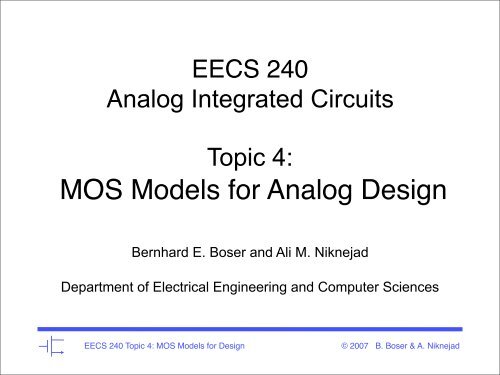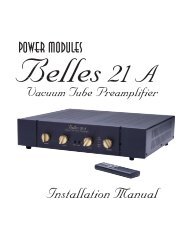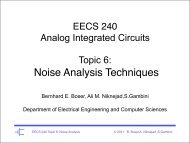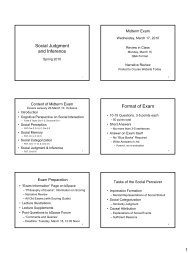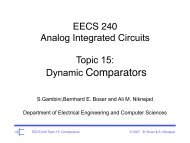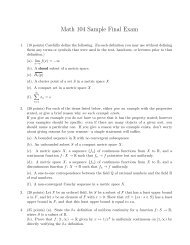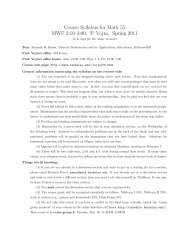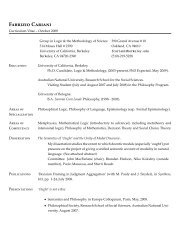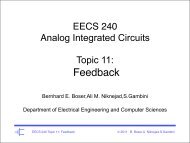T04 mos small signal model_simone.pdf - bSpace
T04 mos small signal model_simone.pdf - bSpace
T04 mos small signal model_simone.pdf - bSpace
You also want an ePaper? Increase the reach of your titles
YUMPU automatically turns print PDFs into web optimized ePapers that Google loves.
EECS 240<br />
Analog Integrated Circuits<br />
Topic 4:<br />
MOS Models for Analog Design<br />
Bernhard E. Boser and Ali M. Niknejad<br />
Department of Electrical Engineering and Computer Sciences<br />
EECS 240 Topic 4: MOS Models for Design<br />
© 2007 B. Boser & A. Niknejad
MOSFET Models for Design<br />
• SPICE (BSIM)<br />
– For verification<br />
– Device variations<br />
– Process design ()<br />
• Hand analysis<br />
– Square law <strong>model</strong> (good for intuition only)<br />
– Small-<strong>signal</strong> <strong>model</strong><br />
• Challenge<br />
– Complexity / accuracy tradeoff<br />
– How can we accurately design when large <strong>signal</strong> <strong>model</strong>s<br />
suitable for hand analysis are off by 50% and more<br />
EECS 240 Topic 4: MOS Models for Design<br />
© 2007 B. Boser & A. Niknejad
More Square Law Model<br />
• In saturation:<br />
• Familiar but inadequate for short channel devices<br />
do not use!<br />
EECS 240 Topic 4: MOS Models for Design<br />
© 2007 B. Boser & A. Niknejad
µC ox<br />
• Square law:<br />
• Extracted values<br />
strong function of I D<br />
–Low I D <br />
weak inversion<br />
–Large I D <br />
mobility reduction<br />
• Do not use µC ox for<br />
design!<br />
EECS 240 Topic 4: MOS Models for Design<br />
© 2007 B. Boser & A. Niknejad
Threshold Voltage V TH<br />
• Strong function of L<br />
• Use long channel for V TH<br />
matching<br />
• Process variations<br />
– Run-to-run ~100mV<br />
– How characterize<br />
– Slow/nominal/fast<br />
– Both worst-case & optimistic<br />
Good design insensitive to Vth, only depends on mismatch in<br />
Vth (can be
Device Parameters for Design<br />
• Focus on metrics that we can directly use in design<br />
• Region: moderate inversion / saturation<br />
– Most common region of operation in analog circuits<br />
– XTR behaves like transconductor: voltage controlled current<br />
source<br />
• Key design parameters<br />
– Large <strong>signal</strong><br />
• Current I D power dissipation<br />
• Minimum V DS available <strong>signal</strong> swing<br />
– Small <strong>signal</strong><br />
• Transconductance g m speed / voltage gain<br />
• Capacitances C GS , C GD , … speed<br />
• Output impedance r o voltage gain<br />
EECS 240 Topic 4: MOS Models for Design<br />
© 2007 B. Boser & A. Niknejad
Low Frequency Model<br />
• A Taylor series expansion of <strong>small</strong> <strong>signal</strong> current<br />
gives (neglect higher order derivatives)<br />
• How do we determine the values of the derivatives<br />
EECS 240 Topic 4: MOS Models for Design<br />
© 2007 B. Boser & A. Niknejad
Weak Inversion g m<br />
• In weak inversion we have bipolar behavior<br />
• Good <strong>model</strong> if transistor is actually used in<br />
weak inversion<br />
EECS 240 Topic 4: MOS Models for Design<br />
© 2007 B. Boser & A. Niknejad
Transconductance<br />
weak<br />
inversion<br />
strong inversion<br />
EECS 240 Topic 4: MOS Models for Design<br />
© 2007 B. Boser & A. Niknejad
Transconductance (cont)<br />
• The transconductance increases linearly with V gs –<br />
V T but only as the square root of I ds . Compare this to<br />
a BJT that has transconductance proportional to<br />
current.<br />
• In fact, we have very similar forms for g m<br />
• Since V dsat >> V t , the BJT has larger<br />
transconductance for equal current.<br />
• Why canʼt we make V dsat ~ V t <br />
EECS 240 Topic 4: MOS Models for Design<br />
© 2007 B. Boser & A. Niknejad
Transconductor Efficiency<br />
• A good metric for a transistor is the transconductance<br />
normalized to the DC current. Since the power dissipation is<br />
determined by and large by the DC current, weʼd like to get the<br />
<strong>mos</strong>t “bang” for the “buck”.<br />
• From this perspective, the weak and moderate inversion region<br />
is the optimal place to operate.<br />
EECS 240 Topic 4: MOS Models for Design<br />
© 2007 B. Boser & A. Niknejad
Efficiency g m /I D<br />
• High efficiency is<br />
good for low power<br />
• Higher g m /I D at low<br />
V GS<br />
• Approaches BJT for<br />
V GS < V TH<br />
g m /I C = 1/V t ~ 40 V -1<br />
• NMOS / PMOS<br />
about same<br />
EECS 240 Topic 4: MOS Models for Design<br />
© 2007 B. Boser & A. Niknejad
Efficiency as a Design Parameter<br />
• If g m /I D is such a good metric, why not use it<br />
for design<br />
• We can always determine its precise value<br />
(from I D and g m ), independent of short<br />
channel effects and other complications.<br />
• The units (V -1 ) and physical interpretation are<br />
a little unusual, but we can easily fix this <br />
EECS 240 Topic 4: MOS Models for Design<br />
© 2007 B. Boser & A. Niknejad
Efficiency g m /I D<br />
• Letʼs define<br />
e.g. V* = 200mV g m /I D = 10 V -1<br />
• Square-law devices: V* = V GS -V TH = V dsat<br />
EECS 240 Topic 4: MOS Models for Design<br />
© 2007 B. Boser & A. Niknejad
Output Resistance r o<br />
Hopeless to <strong>model</strong> this with a simple equation<br />
(e.g. g ds = λ I D )<br />
EECS 240 Topic 4: MOS Models for Design<br />
© 2007 B. Boser & A. Niknejad
Open-loop Gain a v0<br />
• More useful than r o<br />
• Represents maximum attainable<br />
gain from a transistor<br />
• Simulation Notes:<br />
• Bias current i dc sets V*<br />
• Use feedback to find the correct<br />
V GS while sweeping V ds<br />
• Use relatively <strong>small</strong> gain (100)<br />
for fast DC convergence<br />
EECS 240 Topic 4: MOS Models for Design<br />
© 2007 B. Boser & A. Niknejad
Gain, a v0 = g m r o<br />
L = 0.18µm<br />
• Strong tradeoff:<br />
a v0 versus V DS range<br />
• Create such plots for<br />
several device<br />
lengthʼ for design<br />
reference<br />
EECS 240 Topic 4: MOS Models for Design<br />
© 2007 B. Boser & A. Niknejad
Long Channel Gain<br />
L = 0.35µm<br />
L a v0 <br />
like long channel device<br />
EECS 240 Topic 4: MOS Models for Design<br />
© 2007 B. Boser & A. Niknejad
Technology Trend<br />
Short channel devices suffer from reduced per transistor gain<br />
EECS 240 Topic 4: MOS Models for Design<br />
© 2007 B. Boser & A. Niknejad
Transistor Gain Detail<br />
45.000<br />
33.775<br />
gm×ro<br />
22.550<br />
11.325<br />
0.100<br />
0.02 0.06 0.1 0.14 0.18 0.22 0.26 0.3 0.34 0.38 0.42 0.46 0.5<br />
VDS [V]<br />
For practical V DS the effect the “short-channel” gain penalty is less severe<br />
(remember: worst case V DS is what matters!)<br />
EECS 240 Topic 4: MOS Models for Design<br />
© 2007 B. Boser & A. Niknejad
Saturation Voltage vs V*<br />
• Saturation voltage V sat<br />
– V DS for which channel pinches off at drain<br />
– Cannot be measured<br />
– Complex equations<br />
• V* = 2I D /g m<br />
– Measure (or simulate) easily<br />
– Complex equations<br />
• “Long channel” (square law) devices:<br />
– V GS – V TH = V dsat = V ov = V*<br />
– Significance:<br />
• Channel pinch-off<br />
• I D ~ V* 2<br />
• r o “large” for V DS > V*<br />
• C GS , C GD change<br />
• V* = 2 I D / g m<br />
• “Short channel” devices:<br />
– All interpretations of V* are approximations<br />
– Except V* = 2 I D / g m (but V* ≠ V dsat )<br />
EECS 240 Topic 4: MOS Models for Design<br />
© 2007 B. Boser & A. Niknejad
NMOS/PMOS Small-Signal<br />
AC Model<br />
gmb vbs<br />
Bulk usually connected to substrate for NMOS<br />
EECS 240 Topic 4: MOS Models for Design<br />
© 2007 B. Boser & A. Niknejad
SPICE Charge Model<br />
• Charge conservation<br />
• MOSFET:<br />
– 4 terminals: S, G, D, B<br />
– 4 charges: Q S + Q G + Q D + Q B = 0 (3 free variables)<br />
– 3 independent voltages: V GS , V DS , V SB<br />
– 9 derivatives: C ij = dQ i / dV j , e.g. C G,GS ~ C GS<br />
– C ij != C ji<br />
Ref: HSPICE manual, “Introduction to Transcapacitance”, pp. 15:42, Metasoft, 1996.<br />
EECS 240 Topic 4: MOS Models for Design<br />
© 2007 B. Boser & A. Niknejad
Small Signal Capacitances<br />
Weak inversion<br />
Strong inversion<br />
linear<br />
Strong inversion<br />
saturation<br />
C GS C ol C GC /2 + C ol 2/3 C GC + C ol<br />
C GD C ol C GC /2 + C ol C ol<br />
C GB C GC // C CB 0 0<br />
C SB C jSB C jsB + C CB /2 C jsB + 2/3 C CB<br />
C DB C jDB C jDB + C CB /2 C jDB<br />
EECS 240 Topic 4: MOS Models for Design<br />
© 2007 B. Boser & A. Niknejad
MOS Capacitance Example<br />
W/L=100/0.5<br />
Cox=ε0εox/tox=15fF/µm 2<br />
Col=0.5fF/µm->Covlap=50fF<br />
Cgs,si=2/3CoxWL+Col=550fF<br />
Cgd,si=Covlap=50fF<br />
Cgs,triode=1/2CoxWL+Co=425fF<br />
Cgd,triode=1/2CoxWL+Co=425fF<br />
Cgs,wi=Covlap=50fF<br />
Cgd,wi=Covlap=50fF<br />
Inaccurate, residual Cgs left<br />
EECS 240 Topic 4: MOS Models for Design<br />
© 2007 B. Boser & A. Niknejad
Layout<br />
HSPICE geo = 0 (default)<br />
HSPICE geo = 3<br />
EECS 240 Topic 4: MOS Models for Design<br />
© 2007 B. Boser & A. Niknejad
Extrinsic MOS Capacitances<br />
• Source/drain diffusion junction capacitance:<br />
• Example: W/L = 100/0.5, V SB = V DB = 0V, L diff = 1µm<br />
AS = AD = 100µm 2 , PS = PD = 102µm<br />
C jn = 85fF C jswn = 50fF C bc = 58fF<br />
Strong Inversion –<br />
Saturation: C sb = 173fF C db = 135fF<br />
Linear region: C sb = 164fF C db = 164fF<br />
EECS 240 Topic 4: MOS Models for Design<br />
© 2007 B. Boser & A. Niknejad
High Frequency Figures of Merit<br />
• Unity current-gain bandwidth<br />
(Long channel <strong>model</strong>, C gd =0)<br />
• For degenerate short channel device<br />
EECS 240 Topic 4: MOS Models for Design<br />
© 2007 B. Boser & A. Niknejad
Efficiency g m /I D versus f T<br />
Speed-Efficiency<br />
Tradeoff<br />
NMOS > PMOS<br />
EECS 240 Topic 4: MOS Models for Design<br />
© 2007 B. Boser & A. Niknejad
Weak Inversion Frequency Response<br />
• The gate channel capacitance capacitance in<br />
weak inversion ~0:Cgs ~ Cgsol<br />
• fT~25Id/Cgsol<br />
• Expression for channel capacitance and fT<br />
• I M is the maximum achievable current in weak<br />
inversion so the factor ( ) < 1<br />
Ref: Tsividis, Operation and Modeling of the MOS Transistor<br />
EECS 240 Topic 4: MOS Models for Design<br />
© 2007 B. Boser & A. Niknejad
Device Scaling<br />
Short channel devices are significantly faster!<br />
EECS 240 Topic 4: MOS Models for Design<br />
© 2007 B. Boser & A. Niknejad
Device Figure-of-Merit<br />
400.00<br />
300.05<br />
fT×gm/ID [GHz/V]<br />
200.10<br />
100.15<br />
0.20<br />
-0.1 -0.06-0.02 0.02 0.06 0.10.13 0.170.20.23 0.270.30.33 0.430000000000001<br />
VGS-VTH [V]<br />
Peak performance for low V GS -V TH (implies low V*)<br />
EECS 240 Topic 4: MOS Models for Design<br />
© 2007 B. Boser & A. Niknejad
Design Example<br />
Example: Common-source amp<br />
a v0 > 70, f u = 100MHz for C L = 5pF<br />
• a v0<br />
> 70 L =0.5µm<br />
<br />
• High gmeff: V* = 100mV<br />
EECS 240 Topic 4: MOS Models for Design<br />
© 2007 B. Boser & A. Niknejad
Device Sizing<br />
• Pick L<br />
• Pick V* <br />
• Determine g m<br />
0.5µm<br />
100mV<br />
3.14mS<br />
• I D = 0.5 g m V* 157µA<br />
• W from graph<br />
(generate with SPICE)<br />
Current Density=0.8uA/square<br />
– Corresponds to W/<br />
L=157/0.8=196.25<br />
– W=W/L*L=98um<br />
– Cgs=600fF,Cgd=50fF<br />
• Create such graphs for<br />
several device lengths for<br />
design reference<br />
EECS 240 Topic 4: MOS Models for Design<br />
© 2007 B. Boser & A. Niknejad
Common Source Verification<br />
• Amplifier gain > 70<br />
• Amplifier unity gain frequency is “dead on”<br />
• Output range limited to 0.12 V – 1.2 V to maintain gain<br />
(about 1V swing, due to NMOS not limiting gain on high side)<br />
EECS 240 Topic 4: MOS Models for Design<br />
© 2007 B. Boser & A. Niknejad
Common Source Verification<br />
Vmin=0.12V<br />
• Amplifier gain > 70<br />
• Amplifier unity gain frequency is “dead on”<br />
• Output range limited to 0.12 V – 1.2 V to maintain gain<br />
(about 1V swing, due to NMOS not limiting gain on high side)<br />
EECS 240 Topic 4: MOS Models for Design<br />
© 2007 B. Boser & A. Niknejad
Small Signal Design Summary<br />
• Determine g m (from design objectives)<br />
• Pick L<br />
– Short channel high f T<br />
– Long channel high r o , a v0 , better matching<br />
• Pick V* = 2I D /g m based on qualitative interpretation of V*<br />
– Small V* large <strong>signal</strong> swing, high current efficiency<br />
– High V* high f T<br />
– Also affects noise (see later)<br />
• Determine I D (from g m and V*)<br />
• Determine W (SPICE / plot) this takes care of short channel effects, etc.<br />
• Accurate for short channel devices key for design<br />
EECS 240 Topic 4: MOS Models for Design<br />
© 2007 B. Boser & A. Niknejad
Device Sizing Chart<br />
Generate these curves for a variety of Lʼs and device flavors<br />
(HW1)(NMOS, PMOS, thin oxide, thick oxide, different V TH )<br />
EECS 240 Topic 4: MOS Models for Design<br />
© 2007 B. Boser & A. Niknejad
Device Parameter Summary<br />
Device Parameter<br />
Circuit Implications<br />
V* • Current efficiency, g m /I D<br />
• Power dissipation (I D )<br />
• Speed (g m )<br />
• Cutoff frequency, f T phase margin, noise<br />
• Headroom, V DS,min<br />
L<br />
W<br />
• Cutoff frequency, f T phase margin, noise<br />
• Intrinsic transistor gain (a v0 )<br />
• Obtain from L, I D (complicated equations!)<br />
• Self loading (C GS , C DB , …)<br />
EECS 240 Topic 4: MOS Models for Design<br />
© 2007 B. Boser & A. Niknejad
Device Variations<br />
• Run-to-run parameter variations:<br />
– E.g. implant doses, layer thickness, dimensions<br />
– Affect V TH , µ, C ox , R, …<br />
– How <strong>model</strong> in SPICE<br />
• Nominal / slow / fast parameters (tt, ss, ff)<br />
– E.g. fast: low V TH , high µ, high C ox , low R<br />
– Combine with supply & temperature extremes<br />
– Pessimistic but numerically tractable<br />
improves chances for working Silicon<br />
EECS 240 Topic 4: MOS Models for Design<br />
© 2007 B. Boser & A. Niknejad
EECS 240 Topic 4: MOS Models for Design<br />
© 2007 B. Boser & A. Niknejad


